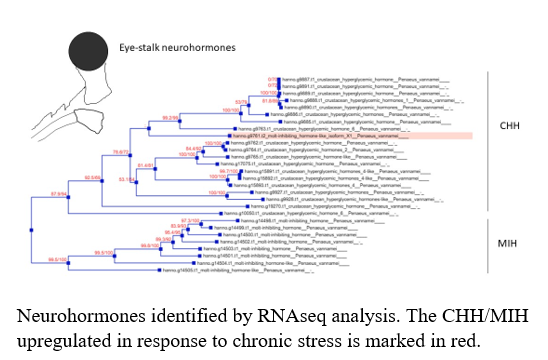REARING STRESS IMPACTS THE ENDOCRINE REGULATION OF GROWTH AND MOLTING IN Litopenaeus vannamei (BOONE, 1931)
Introduction:
Shrimp farming rapidly increased over the past decade, currently comprising 6.8 billion t in Whiteleg shrimps Litopenaeus vannamei alone [1]. At the same time, concerns about the animal welfare have been raised and legislation on farming has been constantly adapted in several countries. Indeed, suboptimal rearing conditions are often not noticed due to lacking criteria and methods [2, 3]. In the interdisciplinary project CrustaWohl we studied stress-related behaviors, easy-to-monitor morphological abnormalities and injuries as well as the molecular basis of chronic stress, focusing on the eye-stalk as endocrine center regulating growth and molting in crustaceans.
Material and Methods:
After three weeks of acclimatization, juvenile Whiteleg tiger shrimps (14.73 ± 0.36 g) were transferred to twelve 600L tanks arranged in a RAS (water exchange one V/h; water renewal 2 %/d) with a biofilter, UV disinfection, protein skimmer, drum filter and an ozone generator, providing three experimental groups reared at different stocking densities (low density (LD): 1 kg/m2, medium density (MD): 2kg/m2, high density (HD): 4 kg/m2 ) and assessed in 4 replicates each.
For sampling, shrimps were euthanized in an ice slurry solution, weight and length were recorded and the molting stage was determined according to Robertson et al. (1987) with a binocular . Only shrimps in the intermolt and early premolt (D0-D1-D2) stages were selected. The eye-stalk was dissected and total RNA was extracted as described in Gamberoni et al. (2025) . Library construction and RNAseq was performed by Novogene (Germany). RNAseq reads were mapped by hisat2 and expression analysis was done by cuffdiff using 5 biological replicates for each condition.
Results and Discussion:
In the eye-stalk as endocrine center for the regulation of growth and molting we identified 28 neurohormones of the crustacean neurohormone family , including 20 crustacean hyperglycemic hormones (CHH) , 8 molt inhibiting hormones (MIH). Among all differentially expressed genes in the eye-stalk, a CHH formerly identified as MIH was up-regulated in the HD group. In crustaceans, the CHH controls blood sugar but also plays a role in molting. Interestingly, the resulting inhibition of growth may thereby shift energy to compensate for the persistent stressor and may function similarly to cortisol in vertebrates increasing plasma sugar in response to stress . Also, a significant growth inhibition was observed at progressively increasing density - both in the HD and MD groups - congruent with this hypothesis. As a conclusion, we believe that this CHH/MIH inhibits growth and molt and regulates hemolymph sugar, shifting energy to compensate chronic stress impact.
Literature:
1. FAO (2024): The sate of aquaculture 2024. The blue transformation in action. Rome. https://openknowledgefaoorg/items/06690fd0-d133-424c-9673-1849e414543d:
2. Gamberoni P, Wuertz S, Bierbach D, Bögner M, Slater MJ (2025): European perspectives on Litopenaeus vannamei aquaculture: An expert’s survey. Aquacult Rep, 42: 1-14
3. Wuertz S, Bierbach D, Bogner M (2023): Welfare of decapod crustaceans with special emphasis on stress physiology. Aquaculture Research, 2023: 1-17

